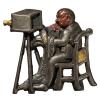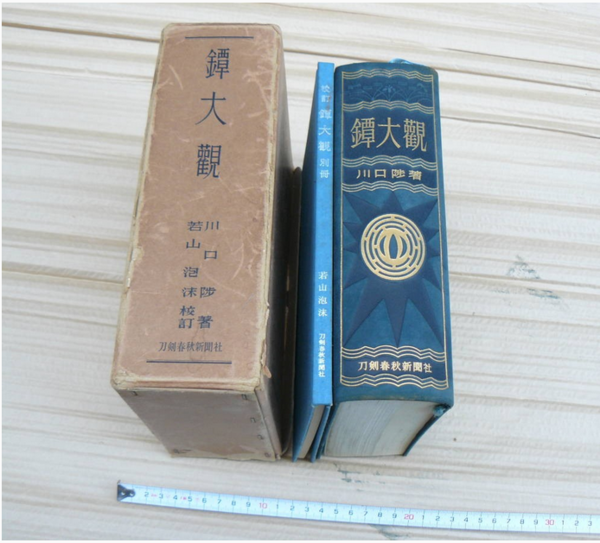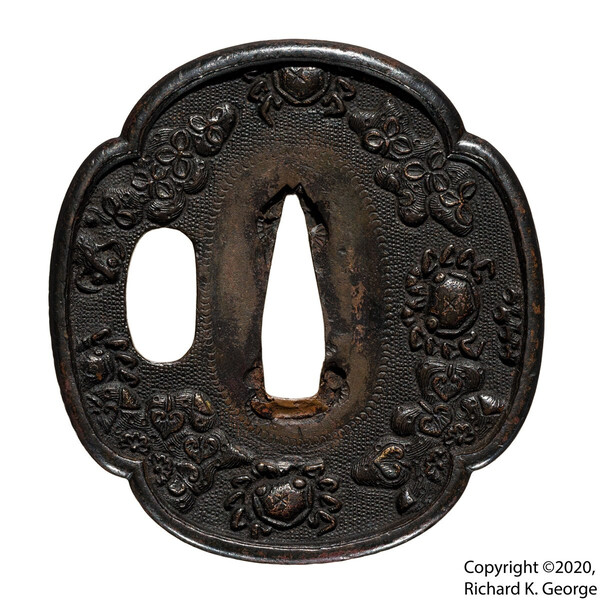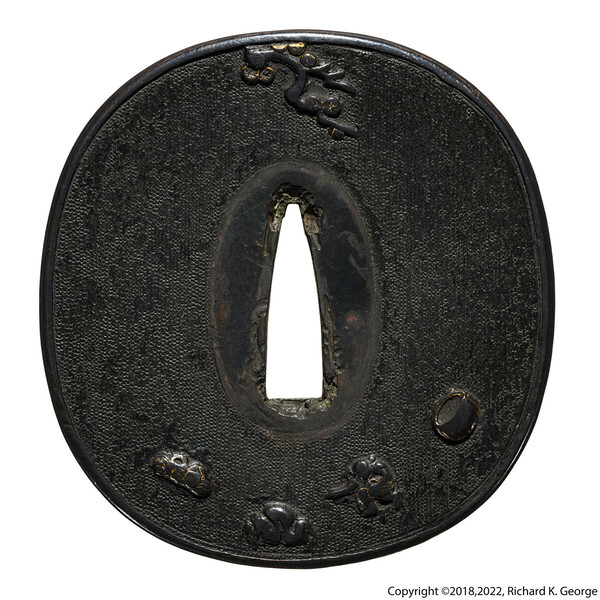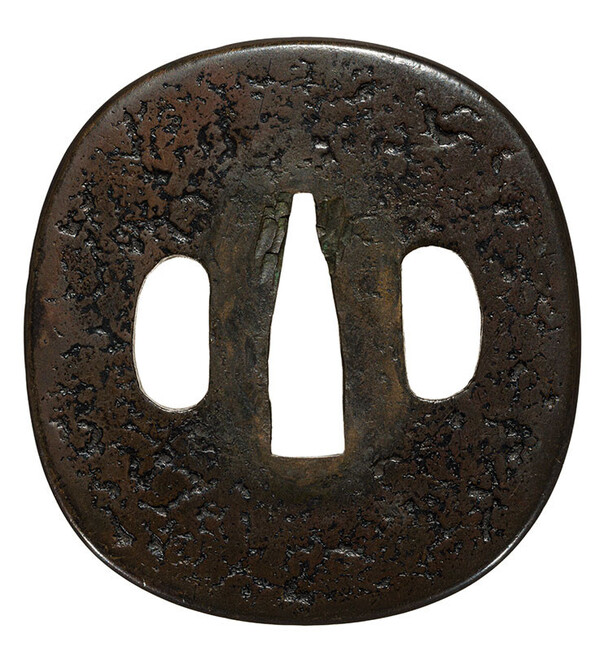-
Posts
834 -
Joined
-
Last visited
-
Days Won
7
Content Type
Profiles
Forums
Events
Store
Downloads
Gallery
Everything posted by rkg
-
Great piece - I guess if nothing else it -could- be binned as Heianjou zougan, but.... it's a step above what you normally see from the groups that produced pieces attributed to Heianjou zougan - I guess some kind of special order from them is a possibility though. I think it's also too old to be somebody like the Washida boys that often created high-quality over-the-top pieces in the heianjou/youshiro style. I am no Jingo expert, but, while a goofy hitsu sometimes points you in the higo group's direction, the hitsu looks either added or like it was modified later to that shape maybe, and... some of the types of inlay are atypical for them, and I feel the design is a little too much for them - I always think of them using simpler/visually more powerful subject matter - and, their iron was often "yummy", which this kind of isn't. Another possibility is some early shouami group. You sometimes make pieces that have several different types of inlay like this piece - Haynes would always joke that they did it to show off their skills - here's a ko-shouami I have that I think fits this - not as complex as your piece, but the mashup of nunome, iroe, inlay, figural work, etc, isn't typical for the Ko shouami guys, so its interesting/might be relevant here: Clear as mud, right? Thanks for sharing the piece. Best, rkg (Richard George)
-
Oops my bad - just posted the link to my agent of choice - here's the actual YJ link: https://page.auctions.yahoo.co.jp/jp/auction/t1088359151 Best, rkg (Richard George)
-
and... the tsuba taikan is another interesting one to thumb through - prices are all over the map though - here's one that just popped up on YJ: https://www.sendico.com/ayahoo/item/t1088359151 Obligatory screen shot from auction grabbed for posterity Best, rkg (Richard George)
-
I've seen these pieces often put in the Ounin or heianjou zougan bins. I'm not sure I'd go with kamakura, because while the ring might have been added, maybe the "drawer pulls" around the outside actually did contain inlay originally? But the form is popular, it could also be some by other group that did inlay (aizu shouami, etc). Is that a shakudo fukurin on it? If so I'd go with that being added later. Best, rkg (Richard George)
-
Good point on the encyclopedia. I still end up using the original all the time though. In a crowded office space small handbooks just on what you're interested in can be your friend (+ its easier to write notes in than the pdf file (for me anyway).). Also, be sure to watch yahoo!Japan for books - sometimes these large Japanese books show up in waves and sometimes they go for amazingly low prices (particularly if you can put up with a non- pristine copy). The trouble is that you can also literally go for years between seeing copies of some of them. And there's actually a large number of interesting books that aren't one of these "classics" that show up all the time, often don't go for much. Best, rkg (Richard George)
-
Jeremy, First off, on the new i phone - I have a pal that has gotten pretty good macro results just shooting through a jeweler's loupe - not exactly repeatable or anything, but when everything aligns it works and you can get some decent images. Sorry about the greek tome on using a microscope for this stuff - it was the muscle relaxants talkin' A lot of those low end inspection options are actually not bad, you can learn a lot with them, but its hard to get really good images (sensors used are necessarily low end), and since that's my groove... I tend to troll for used older gear - sometimes you get lucky.... Rant about working at places with amazing metrology gear before I got interested in this stuff omitted. Best, rkg (Richard George)
-
Jeremy, You might contact Markus directly about that. Best, rkg (Richard George)
-
Boy, that's tough, as there are actually a LOT of books out there that might be useful for you. All of the above are good, but here are a few off-the-wall suggestions you might look at. If you want to look at a large number of different styles themes, etc organized by what group made them, you might look at getting a copy of Tsuba Shusei (the elephant book) by Nakamura - mostly b/w images unfortunately, but it is quite the collection of pieces: https://www.japaneseswordbooksandtsuba.com/store/book/fittings-books/b525-tsuba-shusei-by-nakamura/ If you are just looking for "style" as in shapes, nomenclature, etc another book that you might find surprisingly useful is Kajihara Kotoken's visual glossary https://www.japaneseswordbooksandtsuba.com/store/book/sword-books/b364-nihonto-swords-of-Japan-a-visual-glossary-Japanese-volume/ Also, I'm not certain if it is in print anymore, but Markus Sesko's Handbook of Sword Fittings Related Terms summarizes a whole lot of kodogu related structures, shapes, construction techniques, etc - real handy when you are looking for the Japanese name for some feature. Good Luck, rkg (Richard George)
-
Jeremy, If you are going for a standard 14, look for one with the trinocular setup. Some stages are better than others for this work as well - the one I got came with a sliding/rotating stage which works pretty well, though I ended up using some of that magic non-linear grease on the sliding mechanism to stiffen it up. I have 10x eyepieces all around (the one that came on the trinocular port also had standard threads so you can easily screw a lens adapter into it). I normally use a 1.6 crop camera (canon SL2 if you care) with a old school 50mm macro lens and I get pretty good results with that if you shoot a white card with each lighting setup/use a gray card to get the exposure kind of correct. I then ALWAYS shoot tethered so you can see what you are focusing on (really nice to do on a big screen). you'll need to at least get a 2.5X objective - its the one I use most - I actually found one of their 1.25X objectives, but it is of limited use because its difficult to get light to the piece around it (you end up REAL CLOSE to the surface) - it might be useful if you had a rig that could apply light through the objective, but YMMV as I've never pursued getting the necessary bits and trying it. Note that there isn't a whole of depth of field so you pretty much always have to focus stack if you want to show much depth when shooting. you can actually get pretty good results by parking the focus at one extreme feature and doing the "turn the knob, take a picture repeat" thing. In general, the new systems are all around better for this (optics can be better, have at least an OK (resolution is usually poor, but...) camera built in, and many will automatically do the focus stacking for you - here's a youtube video I posted on the kodogu no sekai site on FB a while back: great to watch since he describes all the issues you will run into... I've posted a bunch of images I've done there over the years/posted some here too... Anyway, agreed on getting some other tools - all my metallurgy classes were sooo long ago so I can't suggest much on what to look for (it doesn't help I'm hopped up on painkillers/muscle relaxants at the moment too) - seems like you'd also want some stuff like an XRF spectrometer gun to play with (I'd dearly love to get one of these if the prices ever come down). Anyway, I should stop rambling now. Best, rkg (Richard George)
-
You have to be super careful with those fiberglass pencils - they will scratch the hell out of your patina if you're not REALLY careful (they go waay too fast)/I wouldn't recommend using them on anything important. That said, they seem somewhat useful to "tap" with (like a mini scaler) on those little mountains of corrosion you find sometimes - again, only as a last resort. You'd also be advised to use random patterns (swirls, etc) rather than linear motion in any other case when you are brushing with them - you see a lot of pieces where they dig at them with whatever in straight lines and it looks terrible when you study the results/look like scratches in your auction images (which is what they are). Aside from Ivory, horn, bamboo chopstick, cloth and the usual round Japanese horsehair brush (good luck finding them), for finer work you can get some small artist's bristle brushes (natural bristle, nothing synthetic for a number of reasons), cut them off close to the ferrule and have at it, though you'll probably have to crimp the ferrule (most of them aren't tight enough to keep the bristle from moving). I've become a big fan of these - its slow, but... and again, try not to always brush in a straight line all the time. For the basket cases there are also these larger Japanese pot scrubbing brushes (made out of bamboo or something) that might work better than the fiberglass brush (they don't damage the surface as much/instantly dig through any patina to raw metal like the fiberglass pens can/do) - but again, you have to be careful with those too as they aren't the most precise tool either. but they are actually common/easy to find/not too expensive/etc. The non fiberglass brushes are also good because you can just use your finger to protect a lot of features and just brush up to it - don't be doing that with the fiberglass brush (an old school metal eraser shield works better, but its metal too, so again be super careful). the non-fiberglass brushes can be slower... but that also gives you lots of time to stop before you've ripped too much off, etc. Also note that a LOT of pieces have wax (often colored - grrr)/oil on them you got to make an effort to get that off on the areas you are working so you can see what is happening. And if you're gonna do fiberglass, it goes everywhere (so be prepared to contain it - I usually make up a 'bowl/tray out of folded paper, let the piece sit on a paper towels. and just thow the while thing away between sessions), you should wear gloves (the little shards are annoying), etc and.. an optivisor/good lighting is your friend. Good Luck, rkg (Richard George)
-
That's a nice looking blade - I suppose you could argue it should be cheaper, but we all argue that, right? - you just kind of have to assume its Gendai/modern/its gonna be difficult to resell/you might take a loss and ask yourself if you like it $1400 much. I spent a scary amount of money getting a modern one polished from its as-finished state, so it seems like a bargain to me/I assume other people would just buy it as well. FWIW, obligatory osoraku image - Mine: Best, rkg (Richard George)
-
Dan, A man after my own heart... Several years ago by sheer luck I picked up a zeiss standard 14 and it kind of changed my world with regards to studying kodogu. I have to add my +1 to Dan's comments - anybody seriously studying kodogu needs something like this, and I'd also recommend a stereo microscope because of the way features just leap out at you. My unit has a trinocular port and while I can get pretty fair images through it you just don't see what you see through the eyepieces. FWIW, I've been thinking of building up a rig to hold my 3-d camera up to the eyepieces and see if I can record the effect (features jumping out at you), but since I think I'm the only guy who has a 3-D camera anymore it went to the bottom of my list. But I digress. My only other comment would be to be sure you actually pony up for some decent lighting. My normal go-to is an old school cold light source with dual gooseneck head, though you can also get some decent illumination using those itty bitty usb powered led lights on some of those usb gooseneck extensions (I have a usb power bank with a couple of outputs that works great as a counterweight for a couple of these). Being able to vary the intensity/direction/type of light is really helpful. There used to be a constant stream of these older units showing up, often with reasonably recent maintenance and dirt cheep (relative to what they cost originally/what a unit of equivalent quality would cost today), but that seems to have dried up unfortunately. Best, rkg (Richard George)
-
cleaned? rkg (Richard George)
-
I know you were asking for kani sukashi, but since some other people have put up others... here's a ko kinko one:\ best, rkg (Richard George)
-
E-books have an awful lot of potential. I played around with creating one or two in the past. You can start with a "book" containing the typical verbiage and images but you aren't bound by the space in a physical book (pun intended) so you can do all kinds of other stuff - use huge images you can zoom waay into to see minute details, have links to many images of an item/additional information, video, vr image sets, 3-d images, audio commentary, video clips, etc etc etc. Buuut... there's little money in creating specialty books to begin with(you're lucky if you break even usually if you include your time, etc), and people are cheep/and most don't think twice about making bootleg copies of any kind of IP in any kind of electronic format ensuring that it is -really- just a labor of love. A few museums (like the Met) will actually eventually put up pdfs of their exhibition publications for public consumption, but that is rare - as I noted earlier they are businesses and they can't stay in business if they don't have money coming in the door to continue operating and it can cost a fortune to do a book "right" - and if there's no return... Its not gonna get done. rkg (Richard George)
-
That's a can of worms. On top of the usual stuff (images were shot that way due to their publication process - diatribe omitted), the reasons can run from museum policy (they have only a few lighting setups they use so all artifacts are shot consistently) to lack of interest by the curator in the artifacts (so they let the intern do the shooting if they bother to image them at all), to their staff photographer/curator not "understanding" what they are shooting (so they use an inappropriate setup), they use the low bidder on the project (don't forget that museums are businesses - which explains the fees, but I digress), etc etc etc. rkg (Richard George)
-
I'm not sure I believe that. If I recall correctly there is like one proported ubu Yujo kozuka, but mysteriously its never been presented for scrutiny by anybody. I think the first Goto where you see known ubu kozuka is Joushin. That of course doesn't really tell you much about what was going on everywhere in Japan, but I suppose it could be posited that at least early on they were in tune with current "fashion" in which case it would indicate when making them/putting them on swords started to become popular enough for the hoity toity to want a rig like that... rkg Richard George
-
On a related note, here's one with NB papers to "den hikozo"- I personally am not sure how they got there as it isn't really up to either the shoudai or nidai's work, but... https://www.sendico.com/ayahoo/item/l1079653149 And here's an image of the piece snarfed from the auction for posterity - I don't own it/the copyright to it and it is being presented for educational purposes only rkg
-
It depends on what you mean by legit. Its probably Higo/hirata work, but the big guy? Maybe, maybe not, which is why the piece is on YJ. It could be by the nidai, could be good later er, utushi, etc. I would guess the seller (0r the P.O.) submitted it to the NBTHK and it bounced or was given papers to somebody else (different generation or the group) or got the dreaded "den hikozo", as even Hozon papers would allow the piece (if legit/attributed to Hikozo with no 'den') to sell for several times the hammer price here. Every once in a while a rube actually does put something up w/o taking steps to maximize value (which is why I guess we all watch YJ), but that is not the case with this seller. They regularly run out some fairly high-grade items (I would posit if he thought it had a snowball's chance in hell of passing as a shoudai piece he would have bought it and had it papered himself even if he couldn't convince the client to do so). I would posit that is why the bidding stopped where it did - that's an OK price for a "den hikozo" piece, but you're taking the risk that its a nidai or a real good utushi, or... Best, rkg (Richard George)
-
I'm sure I've posted this here somewhere before, but here's a few Christan symbols from Japan, a modern Jesuit symbol, etc. I see my other tokei has already had a link to it posted. Best, rkg (Richard George)
-
Lee, Let's see, where to begin. First off, you probably need a few more tools in your "box" - something made of bamboo (I seem to use chopsticks a lot) as well as brushes of various kinds are also extremely helpful for dealing with minor corrosion. I'm partial to those Japanese horsehair brushes and small natural bristle (or sometimes sable) artists brushes with most of the brush cut off (I leave about ~1/8" (3.2mm) sticking ). And cloth of course - you can rub through several layers with a chopstick end for finer work. There are also these large brushes that are made out of bamboo or something they use for cleaning pans or something I think - it can do a number on large areas of corrosion, but you have to be really careful with those. In general the brushes/cloth are slower and it is much harder to damage "good" patina, though you still have to be really really careful around nunome - I've had pieces where the nunome is corroded from the back, hanging by a thread or was basically glued on by wax and it basically fell off - I was really sad with the following one - a piece of the kanji just simply fell off while I was carefully handling the piece trying to figure out where to begin (the piece had a heavy layer of wax hiding a multitude of sins). Second, many tsuba have been doctored a lot and are coated with a heavy layer of wax to minimize/obscure real issues. As Jean alluded to, It's sometimes a real hard choice to decide what should be done to a piece when you are trying to fix corrosion like this, as often most of what you are looking at isn't "real" crud, but stuff added by a later collector/dealer to make the piece look/sell better. This stuff is kind of evil as it is protective of stable patina - but when put over corrosion it does little to inhibit it (n fact I think it helps it as it forms a crust that allows the bad rust to continue corroding under it), it gums up your brushes, lubricates the surface so the ivory isn't as effective, etc - but... stripping the whole piece can also lift off legitimate old crud (think of any area you can't touch/wouldn't touch in use) and there are too many restorers in the world that indiscriminately remove the stuff you look at to determine the age of a piece. It is really sad to see a legitimate ko-kinko piece made to look like an Edo period copy :-/ But I digress. There are times when the piece has so many problems that you have little to lose by boiling, etc but as often or not you can use isopropyl alcohol to get the wax off where you want to work. But on the other hand, if you are using ivory it ablates off and fills the surface of the rust goober and you -have- to periodically remove that (usually by washing the piece) in order to continue working on it. And I guess that's third - you have to think real carefully about where to conserve and how much - my personal rule is not to mess with any area you couldn't touch with your finger easily when handling the piece, but that's my opinion and I'm sure others have different ones. And finally, don't expect miracles - While there are some pieces that tend to corrode "elegantly" (early yamakichibei often do, some ko tosho/katchushi, etc), most pieces don't, and when you chip off ugly spots like the one in your picture as often as not the base surface isn't going to look very good (looks like sandpaper or deep pits, etc). And sometimes you end up with little "mountains" of corrosion that just aren't going to come off w/o extreme measures. In general you can't turn a sow's ear into a silk purse w/o some really brutal work ( redong the surfaces and/or repatinating, filling pits/other damage with bondo and painting, putting on a heavy layer of wax to hide stuff, etc). They would repatinate back in the day, but man, if you have a piece you think has been primped by any modern restorer, you're better off not touching it, as you have no idea what's underneath (or sometimes you do - there are some really badly bodged pieces as well as modern er, utushi on Yahoo!Japan these days). Good Luck, rkg (Richard George) P.S, also, when working on areas like that, think small circular motions - I've seen a tremendous number of peices where rust was scraped off with linear motions and they ran off onto the good patina on either side and it looks like hell (until they put that heavy layer of wax on....).
-
I recently purchased a couple of the 5 tsuba stands - I'm still not sure where the second one is going, here's one down in a display case in the photo studio - they work pretty well - here's a quick not-so great image (its in a bad place to shoot): Best, rkg (Richard George)
-
Yeah, about that... years ago Ford took an xrf gun to a bunch of sinchu inlay/sinchu pieces, and found that the percentage of zinc was pretty consistent ~30% or so if I recall correctly (Ford can hopefully comment or reprint his results). You need an alloy of zinc somewhere in that range (or higher) to make the brass malleable enough to inlay work. The big problem with this whole melt theory is that the Chinese brass has a range that is mostly lower than that (though they seemed to have some brass in that range), and... it turns out that as noted earlier, a fair percentage of the zinc flashes off when you melt the brass and... you end up with too little zinc in the resulting melt to be useful for inlay work. So something else was going on. Either the inlay material is all newer, dating from when they could get spelted brass (European), they were importing brass from somewhere in Asia just for this inlay work, somebody was bringing in zinc to mix in to get the alloy percentage up in coin or other melt, or some other explanation. The Indians seemed to be making zinc quite early, and I have been told there is apparently some research out of Japan claiming they were getting zinc (either as the calamine or as actual alloy of some kind) to do this (though YMMV on that - I could never locate the paper though quite a few Japanese collectors told me it was out of one of the many universities in Kyoto). Probably somebody could do an isotope analysis on old fittings/compare them to "known" sources and see where the component materials actually came from, but... This was too big to link, but here's an analysis of the metal composition of Chinese coins: http://www.rkgphotos.com/facebook_stuff/RP 152 Metall Analysis Chinese coins-Prelims-Appendix.pdf And I'll attach a paper about zinc in china in the 14-1500s for your reading pleasure. I'd attach more, but the papers aren't small... Best, rkg (Richard George) Zinc in the Ming and early Qing.pdf
-
FWIW, you have to kind of be careful when you decide to do that. Using anything caustic will remove any period urushi that's on the piece in short order, the piece might have been "brown waxed" or otherwise primped at some point and you can open yourself up to a world of pain if/when you blow a hole in that (do you try and copy whatever they did, strip the piece and deal with the rust, etc). And actually, while probably not true for this piece, on some work that wax can be original to the piece (Hirata work for example) and they would use multiple layers of different colors of wax to create effects. I don't happen to have a pristine Hikozo to show this (someday maybe), here's an example where the wax is original to the piece as part of its decoration: Best, rkg (Richard George)


